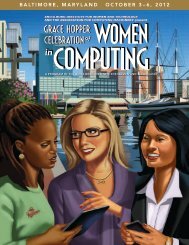ABI-ONE ghc program v14.indd - Grace Hopper Celebration of ...
ABI-ONE ghc program v14.indd - Grace Hopper Celebration of ...
ABI-ONE ghc program v14.indd - Grace Hopper Celebration of ...
Create successful ePaper yourself
Turn your PDF publications into a flip-book with our unique Google optimized e-Paper software.
GENERAL POSTER SESSION<br />
W e d n e s d ay | s e p T 3 0<br />
Learning Anywhere?<br />
Presenter: Olutayo Boyinbode (University<br />
<strong>of</strong> Cape Town)<br />
Ubiquitous Computing is a brand –<br />
new and human centered computing<br />
paradigm, which is seamlessly embedded<br />
into every fabric <strong>of</strong> our lives. Ubiquitous<br />
learning also called U-learning is based on<br />
ubiquitous technology.<br />
The most important and complete role<br />
<strong>of</strong> Ubiquitous computing technology in<br />
U-learning is to construct a ubiquitous<br />
learning environment, where any woman<br />
is able to learn at anyplace and anytime.<br />
African Women can be empowered through<br />
U-learning.<br />
LEMON: A Cheap and Accurate Indoor<br />
Localization Technique<br />
Presenter: Israat Tanzeena Haque<br />
(University <strong>of</strong> Alberta)<br />
Indoor localization is a challenging problem<br />
due to the unavailability <strong>of</strong> GPS under<br />
the ro<strong>of</strong>. One solution to such localization<br />
problem is to use RF-based pr<strong>of</strong>iling.<br />
With pr<strong>of</strong>iling, the problem <strong>of</strong> localization<br />
boils down to data mining in a database<br />
<strong>of</strong> pr<strong>of</strong>iled samples and then averaging<br />
the coordinates <strong>of</strong> best-matched samples<br />
into an approximate location. We propose<br />
a novel pr<strong>of</strong>iling-based indoor localization<br />
scheme dubbed LEMON, which <strong>of</strong>fers high<br />
accuracy but simple and inexpensive.<br />
Lessons Learned in Selecting,<br />
Developing, and Assessing Outreach<br />
Curriculum for Middle School Girls<br />
Presenter: Nannette Napier (Georgia<br />
Gwinnett College)<br />
This poster will provide insights from<br />
multiple perspectives on appropriate<br />
outreach to middle school girls, relative to<br />
existing resources. Some <strong>of</strong> us share years<br />
<strong>of</strong> experience with camps and workshops<br />
with many resources at our disposal. While<br />
others are starting from “Scratch” at a new<br />
college with no existing <strong>program</strong>s. We share<br />
strategies for selecting, designing, and<br />
assessing curriculum and provide concrete<br />
examples <strong>of</strong> effective <strong>program</strong>s for middle<br />
school outreach.<br />
Measuring the Value <strong>of</strong> Enterprise<br />
Architecture - A Metrics Driven<br />
Approach<br />
Presenter: Manasa Basavaraju<br />
(Pennsylvania State University)<br />
Enterprise Architecture (EA) is increasingly<br />
being adopted by large enterprises these<br />
days. Yet the research related to its value<br />
measurement is very limited. This research<br />
attempts to investigate the current state <strong>of</strong><br />
EA value measurement in organizations and<br />
measurement techniques. Here we extend a<br />
well known measurement technique called<br />
Goal-Question-Metric to EA by adding new<br />
features and propose a conceptual model<br />
which organizations can utilize to evaluate<br />
their EA <strong>program</strong> efforts.<br />
Metadata Annotation Support System<br />
Using Blogs and Personal LifeLogs<br />
Presenter: Airi Sonehara (Tsuda College)<br />
“Lifelogging” refers to creating records<br />
<strong>of</strong> individuals’ life experiences. Recent<br />
progress <strong>of</strong> storage technology and<br />
wearable devices has made lifelogging<br />
much easier. In addition, consumers can shift<br />
their focus away from taking pictures and<br />
focus on reusing content. Nonetheless, it is<br />
time-consuming to find pictures from huge<br />
multimedia data collections. Efficient search<br />
environments can be created by using<br />
personal lifelogs. We propose a metadata<br />
annotation system to support multimedia<br />
content reuse.<br />
Methyalted DNA Sequence Alignment<br />
Presenter: M. Elizabeth O. Locke<br />
(University <strong>of</strong> Western Ontario)<br />
In bioinformatics, comparing biological<br />
sequences is fundamental to research.<br />
However, DNA methylation <strong>of</strong> the sequence<br />
at specific sites can affect sequence regulation<br />
and function between species, tissues,<br />
and disease states.<br />
To compare these annotated sequences<br />
efficiently and meaningfully, we augment<br />
traditional dynamic <strong>program</strong>ming alignment<br />
algorithms and incorporate methylation<br />
pr<strong>of</strong>iles directly. This approach could further<br />
biological study and enable effective<br />
searches through very large databases<br />
required for methylated DNA sequence data.<br />
Mobile Collaboration - “Base <strong>of</strong> the<br />
Pyramid” Phones with Implications for<br />
Emerging Geographies<br />
Presenter: Kiran Grover (IBM India Private<br />
Ltd.)<br />
With increase in mobile penetration<br />
across the globe, mobile-phones have<br />
become important mean for collaboration.<br />
Mobile-Collaboration can be <strong>of</strong> great help to<br />
uplift people living at Base <strong>of</strong> Pyramid(BoP).<br />
It can help to raise people socially and<br />
economically. This presentation will focus on<br />
BoP in Rural Indian market, their requirements<br />
and how Mobile-Collaboration can<br />
help. This will also discuss technological<br />
tailoring required in mobile hand-sets to<br />
fulfill the demands.<br />
Modeling the Distribution <strong>of</strong> Mouse<br />
Mediated Responses<br />
Presenter: Maria Vicente Bonto-Kane<br />
(North Carolina State University)<br />
HCI methods rely on KLM GOMS and<br />
Fitts’s Law models to predict mouse<br />
movement times for accessing icons on<br />
an interface. Current models, however,<br />
generate single point estimates. This<br />
research presents methods using distribution<br />
modeling. The lognormal model along<br />
with empirically derived parameters helped<br />
in distribution modeling <strong>of</strong> response times<br />
and <strong>of</strong>fered not only confidence intervals but<br />
also quantiles for predicting performance<br />
boundaries <strong>of</strong> users.<br />
Anita Borg Institute for Women and Technology | <strong>Grace</strong> <strong>Hopper</strong> <strong>Celebration</strong> <strong>of</strong> Women in Computing 57




